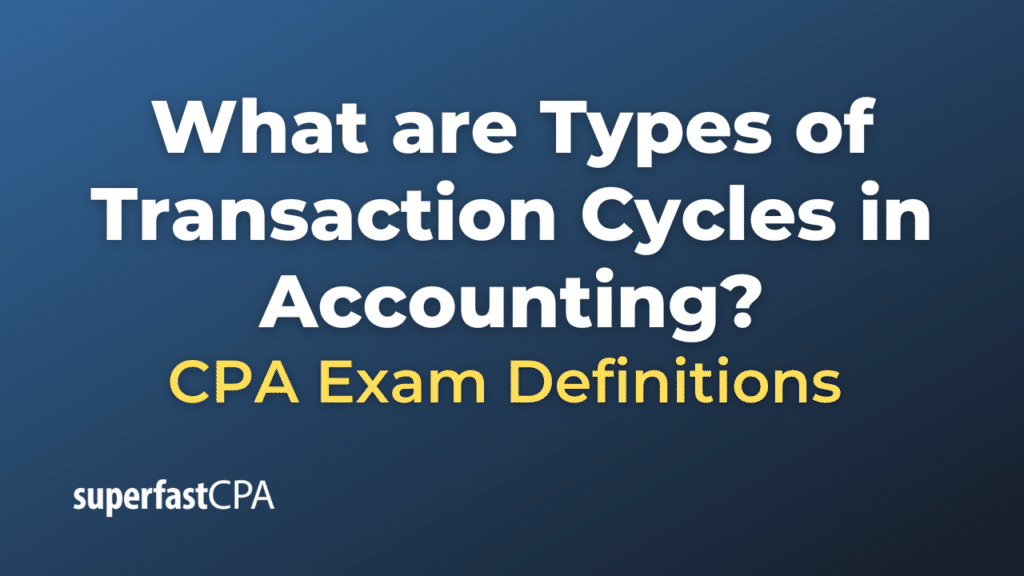Types of Transaction Cycles in Accounting
Transaction cycles in accounting refer to the different categories of business activities for which companies record and process information in their accounting systems. These cycles encapsulate the entire process from the initiation of a transaction to its final posting in the financial statements. Understanding the different transaction cycles helps in organizing data, designing effective controls, and ensuring that transactions are recorded and processed accurately. Here are some primary transaction cycles in accounting:
- Revenue (Sales) Cycle:
- Involves all activities related to sales or services to customers.
- Key processes: order taking, credit approval, shipping, billing, cash receipt.
- Purchases (Expenditure) Cycle:
- Encompasses activities related to the procurement of goods or services.
- Key processes: purchase order issuance, receiving goods or services, invoice processing, cash disbursement.
- Payroll (Personnel) Cycle:
- Deals with all activities related to employee compensation.
- Key processes: timekeeping, wage rate determination, payroll computation, payroll disbursement, tax and other deductions.
- Production Cycle:
- Relevant for manufacturing entities.
- Involves activities related to the conversion of materials into finished goods.
- Key processes: raw material requisition, production scheduling, production, storage.
- Finance and Investment Cycle:
- Focuses on activities related to raising capital, managing investments, and other financing activities.
- Key processes: issuing bonds or shares, dividend distribution, buying or selling investments.
- Fixed Assets (Property, Plant, and Equipment) Cycle :
- Deals with activities related to tangible long-term assets used in the business.
- Key processes: acquisition, depreciation, maintenance, disposal.
For each of these cycles, companies must design and implement internal controls to ensure the completeness, accuracy, and validity of the transactions processed. The specific transactions and controls will vary depending on the nature of the business, its size, and the complexity of its operations.
Example of Types of Transaction Cycles in Accounting
Let’s delve into the Revenue (Sales) Cycle with an example of a fictional company, “NovelBooks Inc.,” which sells books online.
NovelBooks Inc. – Revenue (Sales) Cycle:
1. Order Taking:
A customer browses NovelBooks’ online store and decides to order three books.
2. Credit Approval:
For customers purchasing on credit (like through a credit card with payment due after a month), NovelBooks will check the creditworthiness of the customer, perhaps by using third-party credit-checking services.
3. Shipping:
Once the order is confirmed and credit (if applicable) is approved, the books are packed and dispatched to the customer’s address.
4. Billing:
An invoice is generated. For direct online payments, the invoice is usually marked as paid. For credit purchases, the invoice would indicate the due date for payment.
5. Cash Receipt:
When the payment is made by the customer, especially for those on credit terms, the cash receipt is recorded. For online payments, this might be instantaneous.
Internal Controls in this Cycle:
- NovelBooks may have a system in place to authenticate the validity of each order (e.g., CAPTCHA, verification emails).
- For credit approvals, there might be a defined threshold. If a customer’s order exceeds this threshold, additional verification might be required.
- Shipping can have controls like tracking numbers to ensure that the goods reach the intended recipient.
- For billing, an automated system might be in place to cross-check the price of the books ordered with the amount on the invoice.
- With cash receipts, reconciliation processes can be implemented where the amounts recorded as received in the accounting system are regularly matched with bank statement amounts.
Scenario Summary:
A customer’s journey with NovelBooks Inc. starts from placing an order to making a payment. At each stage of this cycle, internal controls ensure that transactions are accurate, legitimate, and complete. For instance, the reconciliation process at the cash receipt stage ensures that the company’s records of payments received align with actual bank deposits, mitigating risks of errors or fraud.
This example provides a simplified view of the sales cycle, with each step involving its own subset of detailed activities and controls. In reality, especially for larger corporations, each step can be much more intricate.













